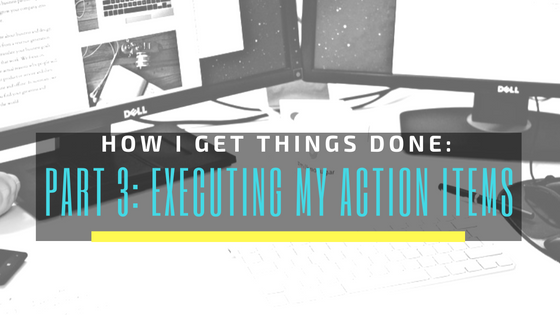
It’s time to talk about how I go about accomplishing all of those goals and completing all the projects on my list. In the introduction of this series, I discussed my needs when it comes to a system for productivity. In the first part of this series, I talked about the different productivity theories that have influenced my system. In the second part of the series, I talked about my system itself. Now, it’s time to talk about how all of that information works together in order to advise me on what I should be working on each day.
It All Starts with The Daily List
Either the night before or at the beginning of my day, I take some time to reflect on how I want to spend my time for the day. I make sure I note down any urgent time commitments – appointments, upcoming deadlines, webinars, etc. – for the day.
For an ordinary day, I then select 3-5 tasks that are my “If I get nothing else but these things done, it will have been a good day.” Those items go at the top of my list. Then, I write down next actions. Some, I group these by context (phone calls, errands grouped by location, etc.), and some I group by the estimated time to completion – 5 minutes, 10 minutes, 20 minutes, longer. That way, when I find myself with the little ones napping, I can batch my phone calls. When I have 5 minutes, I can knock a task off that will take me 5 minutes.
For items where I don’t have specific upcoming deadlines, or a sense of urgency, I do something a bit different. I make a list of all the next actions I can take and number the list. There are 32 lines on a sheet of college-ruled paper, so often my list is 32 items long. Sometimes, I’ll double up. I’ll have a 64-item list. This list is only for items without a specific deadline. These are projects I want to move forward, in some way, but no one is waiting on me to finish these. These are blog plans, books I’m writing, business plans, etc. I’ll often work from this list for a week at a time before generating a new list. This list contains items I can work on immediately, no matter what the situation is – phone calls and errands would not go on this list. Tasks requiring long stretches of dedicated attention do not go on this list.
Organizing My Day’s Schedule
After I put my list together, I figure out when I’ll do things. As mentioned, phone calls during the day need to be made during naps. I try to schedule phone call times ahead using email so that I can be sure the individual I need to talk to is available at that time and that I don’t have a loud toddler and infant singing the song of their people in the background while I try to talk on the phone. I also make note of anything that requires a lot of attention or a long stretch of not having interruptions, editing, or cutting fabric, for example. Those tasks are also scheduled for naptimes or times when my husband or teenager is home to take over on the young child tending duties. Errands are discussed, and if it’s something that can be delegated out, it gets delegated out.
What I’m left with, then, is a list of tasks that can be done at any time during the day so long as it’s before the end of the business day, and a list of tasks that can be done at any point during the day.
Working Through the List
I assess my energy levels. If I have high energy and a high level of motivation, I simply start at the top of my list, using the Pomodoro Technique. I also use the Pomodoro Technique when I’m working on those longer projects that require a lot of focus.
If I’m having a hard time getting motivated, but I have a good amount of energy, I use a random chooser and the Pomodoro Technique. If I’m having one of “those” days that’s chaotic, I use a 5-minute timer and a random number generator.
The Pomodoro Technique, in a Nutshell
I’m going to tell you a secret. I never just work on something, straight through, without taking small breaks. I feel like avoiding long sessions of sitting and staring at a screen or a sewing machine helps my productivity out a lot. Instead, I work in chunks of time. The Pomodoro Technique is one I’ve been following for a while. I work for 25 minutes, then take a 5-minute break. During this 5 minute break, I do things like walk around, read a book to a child, read my own “for pleasure” book, play a dumb Facebook game (DFG), or check-in for a brief chat with a friend on an instant messenger. That completes one Pomodoro. Once the break is up, I get back to work for the next 25 minute stretch. After four Pomodoros, I take a longer break – one from 20-30 minutes. This helps to keep me from burning out. It’s amazing how much you can get done when you’re working in chunks like this.
When I’ve got a clear plan of action, I can usually get my 3-5 must-do tasks done plus some of those other “it would be nice to” tasks done.
When I’m struggling to get started, I’ll often take those 3-5 tasks that have to be done and enter them here. Then, whatever task comes up is the task I work on for the 25-minute stretch. After my break, I choose a new activity, again, randomly. Sometimes at the end of a Pomodoro, the task is done, sometimes it requires more than one round.
When Things Get Funky
Many days, I finish those 3-5 tasks with plenty of time left. Other days, I don’t have specific tasks that have to be done on that day. When that happens, I pull out that long list. I turn to Random.org’s integer generator. I pull up a 5-minute timer, and I will randomly select a task and work on it for just 5 minutes. Some action items are knocked out this way. Some I just make progress on. I repeat this 4 more times then take a 5-minute break. This is a great way to make a little progress on a lot of different things. It also makes getting things done into a game.
I got the idea for the timer from Get-It-Done Guy’s article “Stop Procrastinating by Speed-Dating Your Tasks.” Some days, Instead of randomizing things, I will just go down a list as he outlines here – I’ll spend 5 minutes on tasks the first time through the list. I try to keep my list to about 10 items when I do things this way.
I got the idea for randomizing my tasks from The Get Everything Done blog. Sometimes I follow this method in a straightforward way. Mostly, though, I combine the two, and I manage to get a lot done with the small chunks of time I have.
It’s Not a Perfect System
The system I use for getting things done isn’t perfect. It requires I keep up on my weekly review, I enter in all new things that come across my desk, and I spend some time each day on the nuts and bolts of maintaining my project management system. However, with commitment and determination, I’m able to get a lot done in the time I have to work. There are other things I do, and I’ll share them in future posts, but in a nutshell, this series has described how I get things done.
How do you get things done? Share your thoughts in the comments.
Be sure to read the rest of the series: Intro; Part I; Part II.







